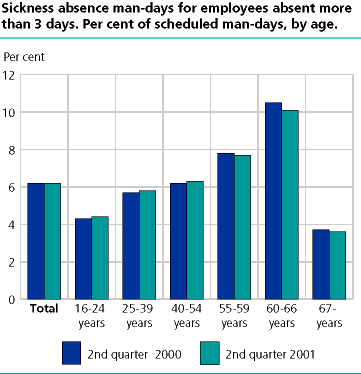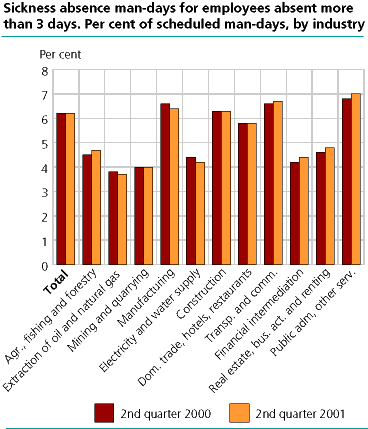Content
Published:
This is an archived release.
Stable sickness absence rate
Sickness absence in Norway remained stable in the period from second quarter 2000 to second quarter 2001. Lost man-days due to sickness constitute 6.2 per cent of scheduled man-days in both quarters. The statistics include all employees. Only sickness absences of more than 3 days with a doctors certificate are included.
New sickness absence statistics
For the first time, Statistics Norway is now presenting entirely new quarterly central statistics on sickness absence. The statistics are created in co-operation with the National Insurance Administration and cover all doctor-certified sickness absences of more than 3 calendar days.
An important term in these statistics is sickness absence rate , which is defined as the number of man-days lost due to sickness absence as a percentage of all scheduled man-days. This takes into account both position (full-time, part-time) and whether the person is on full or partial sick leave.
Besides lost man-days in the quarters due to sickness, the statistics also provide figures on number of persons on sick leave at the end of the quarter. At the end of second quarter 2001, 102 169 employees were on full or partial sick leave, which is 222 more than one year ago.
Sickness absence increases with age
In the age group 16-24 years the sickness absence rate is 4.4 per cent. The absence rate increases with age, peaking out at 10.1 per cent in the age group 60-66 years. The age group 66-69 years is a notable exception, though, with an absence rate of 3.6 per cent. This is because older people who are ill choose to retire with pension, leaving those who are healthiest still employed.
From second quarter 2000 to second quarter 2001 the sickness absence rate increased for the youngest age group and declined for the oldest group. For the oldest, the decrease was most notable in the age group 60-66 years, which showed a decline of 0.4 per cent.
High absence rate in health and social services, low absence rate in financial services
Of the major industries, sickness absence is highest in the health and social services industry, where the absence rate is 8.5 per cent. The overland transport and food and beverage industries also had a high sickness absence rate. The lowest sickness absence rates among the major industries were in financial services (4.4 per cent) and business services and property management (4.8 per cent). In a more detailed industrial breakdown, we see low absence rates in several industries in the business services sector. Mining is a small industry with a low sickness absence rate. The sickness absence rate in oil and gas production is low, but we are a bit uncertain about the reporting rate for persons working on the continental shelf.
From second quarter 2000 to second quarter 2001 the sickness absence rate declined by up to 0.2 percentage points in oil and gas production, manufacturing and power and water supply. In the primary industries, transport, financial services, business services and public administration, the sickness absence rate rose by up to 0.2 percentage points from 2000 to 2001.
Women have a higher sickness absence rate than men
Women generally had a higher sickness absence rate than men in second quarter 2001. The rate was 7.8 per cent for women and 5.0 per cent for men. Women have a higher sickness absence rate than men in all age groups. The greatest gender difference is in the age group 30-34 years, where men have a 4.3 per cent absence rate and women 8.0 per cent. Most likely, this is mainly attributed to sickness related to pregnancy.
The tables also show that women have a higher absence rate than men in all industries. This does not necessarily imply that women per se are the main reason for the difference, although sickness in connection with pregnancy is a womens factor that raises the absence rate. Differences in the division of labour between women and men vary greatly among occupations and may explain some of the differences in sickness absence. For example, there are significantly more women than men employed in cleaning and health and social services, where we know from other sources that the absence rate is high. Occupational data is still not included in the records on which these statistics are based, but we have begun compiling records based on employers reports to the register of employees.
Duration of sickness absence
The duration of sickness absence can be measured in various ways, some of which require more data than others. The figures herein are based on a relatively simple method, but one which provides current figures as well as an ample picture of how the duration changes over time and varies among groups. This is the same method use for calculating the duration of unemployment.
Longest duration of sickness absence in education
Of the 102 000 employees absent more than 3 days due to sickness at the end of second quarter 2001, 27.4 per cent were absent for more than 6 months. This is the same percentage as last year. The percentage of those absent more than 6 months due to sickness in the education industry was 37.5 per cent.
The duration increases with age. Among employees absent due to sickness at the end of the second quarter, the portion of those absent more than 6 months was 10.1 per cent among those who were 16-19 years of age, 27.9 per cent among 45-49-year-olds and 45.6 per cent among 65-66-year-olds.
The tables contain figures for duration of ongoing sickness absence at the end of the quarter. This by itself yields a lower figure for average duration than if we had waited until the cases of sickness absence had concluded . On the other hand, duration is measured only for sickness absence cases on a given day . Had we looked at all cases of sickness absence in the quarter , we would have included more cases of absence. And the growth in absence rate would have been greatest for the cases of short absences. A long longer reference period would by itself have yielded a somewhat lower figure for average duration. Later we will also present figures for duration based on concluded sickness absence cases and for various reference periods.
Sickness absence in employer period
Figures for duration of ongoing sickness absence do not give an accurate measure of how great a part of the sickness absence falls within the period in which the employer is required to cover sick pay. To obtain data on that, the duration must be calculated on the basis of concluded cases of sickness absence.
Figures on short-term absence will come later
Sickness absence in the self-certification period, usually 1-3 days, is not covered by these statistics. Statistics Norway has a separate compilation of data on such absences from a selection of companies in all industries. The results of that data will be presented later and will then be compared with data on doctor-certified absences so as to provide more comprehensive statistics.
About the statistics
The statistics are based on the National Insurance Administration register of doctor-certified sickness absences. Reported absences of durations of 1-3 calendar days are not included in the statistical basis since this is a period usually covered by a self certificate in most cases. A number of employers have introduced an extended self - certificate period . Consequently, the sickness certificate register no longer covers 100 per cent of sickness absences of more than 3 days. Checks that have been carried out do not indicate that the growth in extended self-certificate periods has had any noticeable effect on the figures indicating rates of change in the current statistics. Persons with a so-called active self certificate , i.e. that they go to work part of the time, are included in the statistics. For more information, click on “About the statistics” to the left.
The statistics is published with Sickness absence.


